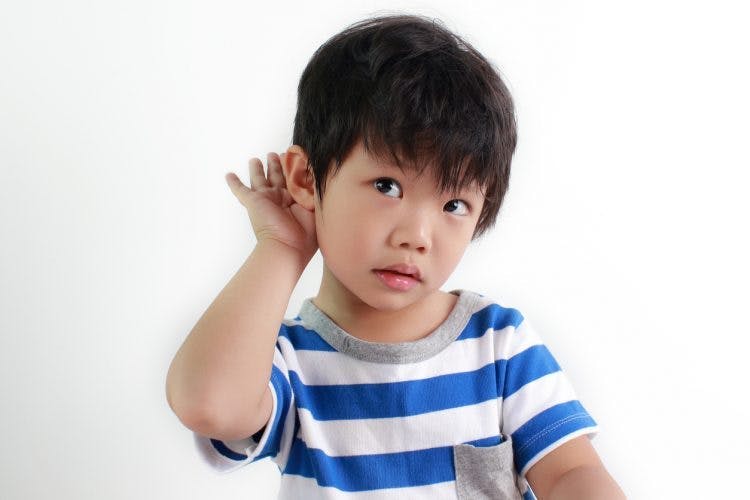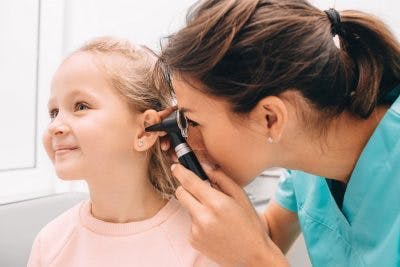No products in the cart.
No products in the cart.
No products in the cart.
No products in the cart.
Home » Neurological Recovery Blog » Cerebral Palsy » Cerebral Palsy and Hearing Loss: Why It Happens & How to Treat It
Last updated on April 20, 2021

Are individuals with cerebral palsy more likely to experience hearing loss?
About 12% of individuals with cerebral palsy experience hearing impairments, according to the American Academy of Neurology. However, the two conditions are not directly related to one another.
To help you understand why cerebral palsy and hearing loss often co-occur, this article will discuss:
Hearing loss is an associative condition of cerebral palsy, meaning that they are caused by two different areas of damage to the brain but often co-occur.
Many risk factors that cause cerebral palsy can also cause hearing problems. Some risk factors that can cause both cerebral palsy and hearing loss include:
Although the causes of CP and hearing impairments are often similar, they are associated with different regions of the brain.
Cerebral palsy is caused by damage to the motor cortex, cerebellum, thalamus, or basal ganglia. In contrast, hearing impairments are generally caused by damage to the parietal and temporal lobes of the brain. Additionally, hearing loss may not even be caused by damage to the brain. Instead, damage to the ear can cause hearing complications.
Generally, hearing loss is more prevalent amongst individuals with more severe forms of cerebral palsy. This is because more severe motor impairments are associated with greater amounts of damage to the brain.
In the following section, we’ll discuss 3 types of hearing loss that individuals with cerebral palsy often experience.

Generally, individuals with cerebral palsy experience 1 of 3 types of hearing loss: conductive, sensorineural, or mixed. Because they vary in causes, symptoms, and prognosis, it’s essential to understand the differences between them to get the right treatment.
Below, we’ll go over the main distinctions between the 3 types of hearing loss and how to manage them.
The first type of hearing loss that individuals with cerebral palsy may experience is conductive hearing loss. Conductive hearing loss affects the transmission of sound in the middle and outer ear.
Because hearing is affected before sounds reach the nerves in the inner ear, individuals experience muffled, unclear sound.
Luckily, conductive hearing loss is often temporary and can usually be treated through surgery, medications, or hearing aids.
Sensorineural hearing loss occurs when there’s damage to the nerve pathways in the inner ear, the hearing-associated neural pathways in the brain, or the part of the brain responsible for perceiving auditory stimuli.
This type of hearing loss is permanent and generally cannot be treated with medicine or surgery. However, hearing aids may be able to help your child manage their hearing impairment.
Mixed hearing loss describes when a person experiences a combination of symptoms characteristic of both conductive and sensorineural hearing loss.
Both the inner ear and middle/outer ear are affected, which makes it both a physical and neurological complication.
Now that you understand the 3 different types of hearing loss that individuals with cerebral palsy often experience, the next section will discuss signs of hearing impairment.
Because individuals with cerebral palsy may struggle with their movements, they must learn how to effectively communicate to relay their needs and socialize. However, hearing loss can significantly affect the development of a child’s language and social skills, which is why early identification and intervention are essential.
Signs of hearing loss include:
Hearing loss can range from mild to profound and affect various parts of one or both ears.
Generally, the younger a child is and the milder their impairment, the more challenging it will be to notice hearing loss. Many times, hearing impairments can be mistaken for cognitive impairment due to a lack of response and confusion.
If your child is demonstrating signs of a hearing impairment, consult with an audiologist to get a professional evaluation.

Managing both hearing loss and cerebral palsy can be complicated. Cerebral palsy affects movement, and hearing loss makes it difficult to understand directions, have conversations, and be aware of one’s surroundings.
Because everyone experiences cerebral palsy and hearing impairments differently, a personalized approach to treatment is essential.
For example, children that only have hearing impairments typically learn sign language to communicate. However, children with cerebral palsy and hearing impairments might not be able to use sign language because they may lack fine/gross motor control.
Below, we’ll discuss some of the most effective interventions to help individuals with cerebral palsy manage hearing impairments.
Individuals with cerebral palsy may see a variety of specialists to address and treat various complications.
Examples of specialists that can help treat complications associated with hearing loss include audiologists and speech-language pathologists.
Audiologists can help evaluate the severity of your child’s hearing impairment and provide helpful management tips.
Speech-language pathologists can help your child learn how to effectively communicate (verbally or nonverbally) and improve their social skills.
If hearing loss is caused by problems with the ears, surgery may be recommended to remove whatever is blocking sound from reaching the inner ear.
This can include problems like deformity, dysfunction from head trauma, fluid buildup, tumors, and otosclerosis (a bone growth disorder).
Doctors may prescribe antibiotics or antifungal medications to treat ear infections and reduce fluid buildup.
Powerful steroids may also be used either orally or by injection to reduce inflammation and swelling in the ear.
Hearing aids are devices that are placed on the ear to amplify sound, allowing individuals to hear more clearly.
They don’t heal ear damage, but as long as the individual wears their hearing aid, they should be able to hear much better.
In cases of severe sensorineural hearing loss, a cochlear implant may be recommended. To clarify, a cochlear implant cannot restore normal hearing. Instead, it works around the damaged part of the ear and directly stimulates the auditory nerve.
Cochlear implants consist of an internal piece that is surgically inserted under the skin and an external component that you place on your ear. They convert sounds into electric impulses and send them off to various frequency electrodes, which gives off the sensation of sound.
The sound experienced with a cochlear implant is different from natural sound. However, younger children tend to quickly adapt to it, which is another reason early intervention is ideal.
Cerebral palsy and hearing loss don’t share a direct relation, but they do occur together often enough that they are associative conditions for one another.
Hearing loss can be mild and difficult to notice, or profound to the point of deafness. Depending on the severity of your child’s hearing loss, treatment methods can be minimal or invasive.
If you think your child may be showing signs of a hearing impairment, don’t hesitate to get a professional diagnosis. Early intervention can help prevent hearing complications from progressing and significantly improve your child’s communication skills.
Hopefully, this article helped you get a better understanding of what to expect, signs to look out for, and treatment options for hearing loss in children with cerebral palsy.

Get our free 19-page PDF full of helpful tips for cerebral palsy by signing up below! If you liked this article, you’ll LOVE our free ebook.
When you sign up, you’ll also receive our popular emails that share more tips for life with cerebral palsy — you can opt out anytime.
We will never sell your email address, and we never spam. That we promise.


At Flint Rehab, we understand that doing physical therapy at home can become tedious and repetitive. But when repetition is critical to recovery, it’s important to stick with a repetitive regimen. But that doesn’t mean it has to be boring.
Flint Rehab is the leading manufacturer of motion-sensing, gamified rehabilitation devices. Our bestselling recovery tool, FitMi, transforms full-body rehab exercises into an interactive experience.
See what individuals with CP are saying about FitMi:
“The FitMi and MusicGlove have done wonders for my son with hemiparesis from cerebral palsy and stroke. It motivates him to do his exercises. It does not seem like therapy for him since it is fun. FitMi monitors his progress so it is a great reinforcement for him. Music is a motivator for him. He has been using it on his arm and we will try the leg exercises soon.”
-Manning
While FitMi is a recovery tool for the full-body, our other device, MusicGlove, helps target the hand to improve fine motor skills and dexterity.
See what others have said about MusicGlove:
“My granddaughter has right-side hemiplegia from Cerebral Palsy / stroke at birth. She states that this is a great product for anyone who has issues with the use of their hand(s), and that is has helped her tremendously. She also finds the music quite catchy (surprisingly!). Our occupational therapist has been impressed as well. I can say that it has arguably been the best tool of all our therapy resources.”
-Jenni
Together, FitMi and MusicGlove make a powerful home therapy regimen for individuals with cerebral palsy. Best of all, you can save money when you bundle them together.
To learn more, click the button below:

Do you have these 19 pages of helpful tips for CP?
Get a free copy of our ebook Helpful Tips for Managing Cerebral Palsy. Click here to get instant access.
Grab a free rehab exercise ebook!
Sign up to receive a free PDF ebook with recovery exercises for stroke, traumatic brain injury, or spinal cord injury below: